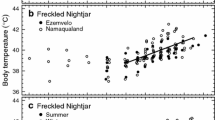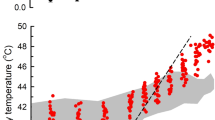Abstract
The emu is a large, flightless bird native to Australia. Its habitats range from the high snow country to the arid interior of the continent. Our experiments show that the emu maintains a constant body temperature within the ambient temperature range-5 to 45°C. The males regulate their body temperature about 0.5°C lower than the females. With falling ambient temperature the emu regulates its body temperature initially by reducing conductance and then by increasing heat production. At-5°C the cost of maintaining thermal balance is 2.6 times basal metabolic rate. By sitting down and reducing heat loss from the legs the cost of homeothermy at-5°C is reduced to 1.5 times basal metabolic rate. At high ambient temperatures the emu utilises cutaneous evaporative water loss in addition to panting. At 45°C evaporation is equal to 160% of heat production. Panting accounts for 70% of total evaporation at 45°C. The cost of utilising cutaneous evaporation for the other 30% appears to be an increase in dry conductance.
Similar content being viewed by others
Abbreviations
- A r :
-
Effective radiating surface area
- BMR:
-
basal metabolic rate
- C dry :
-
dry conductance
- CEWL:
-
cutaneous evaporative water loss
- EHL:
-
evaporative heat loss
- EWL:
-
evaporative water loss
- FECO2 :
-
fractional concentration of CO2 in excurrent air
- FFH2O :
-
water content of chamber excurrent air
- FEO2 :
-
fractional concentration of O2 in chamber excurrent air
- FICO2 :
-
fractional concentration of CO2 in incurrent air
- FIO2 :
-
fractional concentration of O2 in chamber incurrent air
- MHP:
-
metabolic heat production
- MR:
-
metabolic rate
- REWL:
-
respiratory evaporative water loss
- RH:
-
relative humidity
- RQ:
-
respiratory quotient\((\dot VCO_2 /\dot VO_2 )\);
- SA:
-
surface area
- SEM:
-
standard error of the mean
- SNK:
-
Student-Newman-Keuls multiple range test
- STPD:
-
standard temperature and pressure dry
- T a :
-
ambient temperature(s)
- T b :
-
body temperature(s)
- T e :
-
surface temperature(s)
- \(\dot V\) :
-
flow rate of air into the chamber
- \(\dot VCO_2\) :
-
carbon dioxide production
- \(\dot VO_2\) :
-
oxygen consumption
- \(VP_{H_2 O}\) :
-
vapour pressure of water
References
Arad Z, Gavrieli-Levin I, Eylath U, Marder J (1987) Effect of dehydration on cutancous water evaporation in heat-exposed pigeons (Columba livia). Physiol Zool 60:623–630
Arad Z, Midtgård U, Bernstein MH (1989) Thermoregulation in turkey vultures: vascular anatomy, arteriovenous heat exchange, and behaviour. Condor 91:505–514
Aschoff J (1981) Thermal conductance in mammals and birds: its dependence on body size and circadian phase. Comp Biochem Physiol 69A:611619
Bech C (1980) Body temperature, metabolic rate, and insulation in winter and summer acclimatized mute swans (Cygnus olor). J Comp Physiol 136:61–66
Bernstein MH, Samiengo FC (1981) Ventilation and acid-base status during thermal panting in pigeons (Columba livia). Physiol Zool 54:303–315
Brück K (1986) Basic mechanisms in thermal long-term and shortterm adaptation. J Therm Biol 11:73–77
Calder WA, Schmidt-Nielsen K (1968) Panting and blood carbon dioxide in birds. Am J Physiol 215:477–482
Calder WA, Dawson TJ (1978) Resting metabolic rates of ratite birds: the kiwis and the emu. Comp Biochem Physiol 60A:479–481
Cracraft J (1974) Phylogeny and evolution of the ratite birds. Ibis 116:494–521
Crawford EC, Schmidt-Nielsen K (1967) Temperature regulation and evaporative cooling in the ostrich. Am J Physiol 212:347–353
Crawford EC, Lasiewski RC (1968) Oxygen consumption and respiratory evaporation of the emu and rhea. Condor 70:333–339
Dawson TJ, Schmidt-Nielsen K (1966) Effect of thermal conductance on water economy in the antelope jack rabbit,Lepus alleni. J Cell Physiol 67:463–472
Dawson TJ, Read D, Russell EM, Herd RM (1984) Seasonal variation in daily activity patterns, water relations and diet of emus. Emu 84:93–102
Dmi'el R, Tel-Tzur D (1985) Heat balance of two starling species (Sturnus vulgaris andOnychognathus tristrami) from temperate and desert habitats. J Comp Physiol B 155:395–402
Drent RH, Stonehouse B (1971) Thermoregulatory responses of the Peruvian penguin,Spheniscus humboldti. Comp Biochem Physiol 40A:689–710
Folkow LP, Mercer JB (1986) Partition of heat loss in resting and exercising winter- and summer-insulated reindeer. Am J Physiol 251:R32-R40
Frumkin R, Pinshow B, Weinstein Y (1986) Metabolic heat production and evaporative heat loss in desert phasianids: chukar and sand partridge. Physiol Zool 59:592–605
Grice D, Caughley G, Short J (1985) Density and distribution of emus. Aust Wildl Res 12:69–73
Hayes JP, Speakman JR, Racey PA (1992) Sampling bias in respirometry. Physiol Zool 65:604–619
Herreid CF, Kessel B (1967) Thermal conductance in birds and mammals. Comp Biochem Physiol 21:405–414
Hill RW (1972) Determination of oxygen consumption by use of the paramagnetic oxygen analyzer. J Appl Physiol 33:261–263
Hinds DS, Calder WA (1973) Temperature regulation of the pyrrhuloxia and the Arizona cardinal. Physiol Zool 46:55–71
Hurlbert SH (1984) Pseudoreplication and the design of ecological field experiments. Ecol Monogr 54:187–211
Hyrtl J (1863) Neue Wundernetze und Geflechte bei Vögeln und Säugetieren. Denkschr Mathem Naturw Classe 22:113–152
Jones JH, Grubb B, Schmidt-Nielsen K (1983) Panting in the emu causes arterial hypoxemia. Respir Physiol 54:189–195
Louw GN, Belonje PC, Coetzee HJ (1969) Renal function, respiration, heart rate, and thermoregulation in the ostrich (Struthio camelus). Sci Pap Namib Desert Res Stn 42:43–54
Maloney SK, Dawson TJ (1993) Sexual dimorphism in basal metabolism and body temperature of a large bird, the emu. Condor 95:1034–1037
Maloney SK, Dawson TJ (1994) Ventilatory accommodation of oxygen demand and respiratory water loss in a large bird, the emu (Dromaius novaehollandiae), and a re-examination of ventilatory allometry for birds. J Comp Physiol B (in Press)
Marder J, Gavrieli-Levin I (1987) The heat-acclimated pigeon: an ideal physiological model for a desert bird. J Appl Physiol 62:952–958
Marder J, Arad Z (1989) Panting and acid-base regulation in heat stressed birds. Comp Biochem Physiol 94A:395–400
Marder J, Raber P (1989) Beta-adrenergic control of trans-cutaneous evaporative cooling mechanisms in birds. J Comp Physiol B 159:97–103
Marder J, Arieli Y, Ben-Asher J (1989) Defense strategies against environmental heat stress in birds. Isr J Zool 36:61–75
Midtgård U (1980) Heat loss from the feet of mallardsAnas platyrhynchos and arterio-venous heat exchange in the rete tibiotarsale. Ibis 122:354–359
Midtgård U (1981) The rete tibiotarsale and arteriovenous association in the hind limb of birds: a comparative morphological study on counter-current heat exchange systems. Acta Zool (Stockholm) 62:67–87
Phillips PK, Heath JE (1992) Heat exchange by the pinna of the African elephant (Loxodonta africana). Comp Biochem Physiol 101A:693–699
Porter WP (1969) Thermal radiation in metabolic chambers. Science 166:115–117
Schmidt-Nielsen K (1979) Animal Physiology: adaptation and environment, 2nd edn. Cambridge University Press, Cambridge, UK
Schmidt-Nielsen K, Schmidt-Nielsen B (1952) Water metabolism of desert mammals. Physiol Rev 32:135–166
Schmidt-Nielsen K, Kanwisher J, Lasiewski RC, Cohn JE, Bretz WL (1969) Temperature regulation and respiration in the ostrich. Condor 71:341–352
Steen I, Steen JB (1965) The importance of the legs in the thermoregulation of wading birds. Acta Physiol Scand 63:285–291
Taylor CR, Dmi'el R, Fedak M, Schmidt-Nielsen K (1978) Energetic cost of running and heat balance in a large bird, the rhea. Am J Physiol 221:596–601
Walsberg GA, King JR (1978) The relationship between external surface area of birds to skin surface area and body mass. J Exp Biol 76:185–189
Weast RC, Astle MJ (1983) CRC handbook of chemistry and physics. CRC Press, Boca Raton, Florida
Winston PW, Bates DH (1960) Saturated solutions for the control of humidity in biological research. Ecology 41:232–237
Withers PC (1983) Energy, water and solute balance of the ostrich,Struthio camelus. Physiol Zool 56:568–579
Withers PC, Williams JB (1990) Metabolic and respiratory physiology of an arid-adapted Australian bird, the spinifex pigeon. Condor 92:961–969
Young BA, Fenton TW, McLean JA (1984) Calibration methods in respiratory calorimetry. J Appl Physiol 56:1120–1125
Author information
Authors and Affiliations
Rights and permissions
About this article
Cite this article
Maloney, S.K., Dawson, T.J. Thermoregulation in a large bird, the emu (Dromaius novaehollandiae). J Comp Physiol B 164, 464–472 (1994). https://doi.org/10.1007/BF00714584
Accepted:
Issue Date:
DOI: https://doi.org/10.1007/BF00714584




